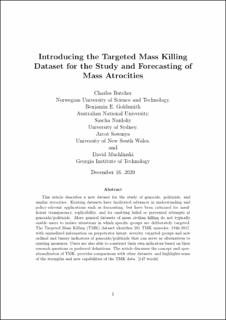| dc.contributor.author | Butcher, Charles | |
| dc.contributor.author | Goldsmith, Benjamin | |
| dc.contributor.author | Nanlohy, Sascha | |
| dc.contributor.author | Sowmya, Arcot | |
| dc.contributor.author | Muchlinski, David | |
| dc.date.accessioned | 2021-02-08T09:46:59Z | |
| dc.date.available | 2021-02-08T09:46:59Z | |
| dc.date.created | 2020-01-06T17:10:17Z | |
| dc.date.issued | 2020 | |
| dc.identifier.citation | Journal of Conflict Resolution. 2020, 64 1524-1547. | en_US |
| dc.identifier.issn | 0022-0027 | |
| dc.identifier.uri | https://hdl.handle.net/11250/2726561 | |
| dc.description.abstract | This article describes a new data set for the study of genocide, politicide, and similar atrocities. Existing data sets have facilitated advances in understanding and policy-relevant applications such as forecasting but have been criticized for insufficient transparency, replicability, and for omitting failed or prevented attempts at genocide/politicide. More general data sets of mass civilian killing do not typically enable users to isolate situations in which specific groups are deliberately targeted. The Targeted Mass Killing (TMK) data set identifies 201 TMK episodes, 1946 to 2017, with annualized information on perpetrator intent, severity, targeted groups, and new ordinal and binary indicators of genocide/politicide that can serve as alternatives to existing measures. Users are also able to construct their own indicators based on their research questions or preferred definitions. The article discusses the concept and operationalization of TMK, provides comparisons with other data sets, and highlights some of the strengths and new capabilities of the TMK data. | en_US |
| dc.language.iso | eng | en_US |
| dc.publisher | SAGE | en_US |
| dc.rights | Attribution-NonCommercial-NoDerivatives 4.0 Internasjonal | * |
| dc.rights.uri | http://creativecommons.org/licenses/by-nc-nd/4.0/deed.no | * |
| dc.title | Introducing the Targeted Mass Killing Dataset for the Study and Forecasting of Mass Atrocities | en_US |
| dc.type | Peer reviewed | en_US |
| dc.type | Journal article | en_US |
| dc.description.version | acceptedVersion | en_US |
| dc.source.pagenumber | 1524-1547 | en_US |
| dc.source.volume | 64 | en_US |
| dc.source.journal | Journal of Conflict Resolution | en_US |
| dc.identifier.doi | 10.1177/0022002719896405 | |
| dc.identifier.cristin | 1767203 | |
| dc.description.localcode | © 2020. This is the authors' accepted and refereed manuscript to the article. This manuscript version is made available under the CC-BY-NC-ND 4.0 license http://creativecommons.org/licenses/by-nc-nd/4.0/ The final authenticated version is available online at: http://dx.doi.org/10.1177/0022002719896405 | en_US |
| cristin.ispublished | true | |
| cristin.fulltext | postprint | |
| cristin.fulltext | postprint | |
| cristin.qualitycode | 2 | |

